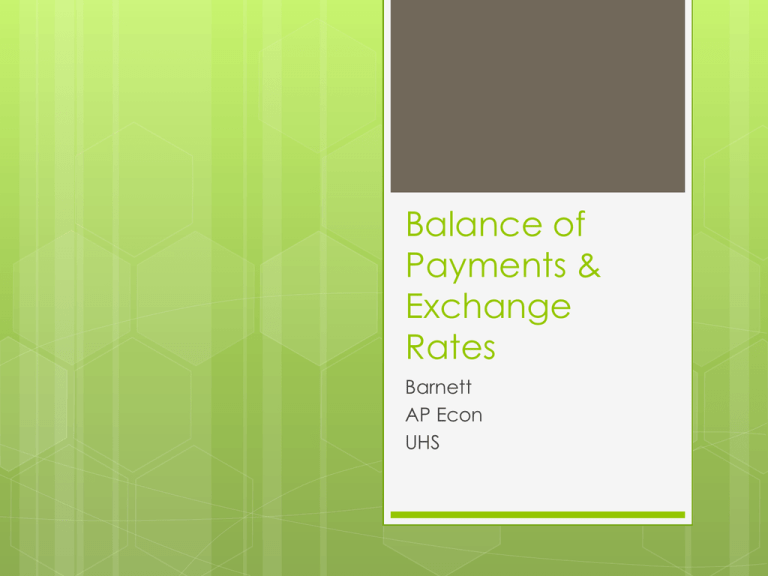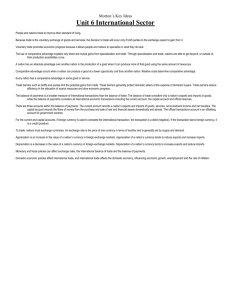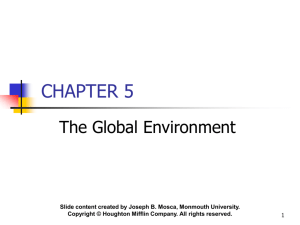Balance of Payments & Exchange Rates
advertisement

Balance of Payments & Exchange Rates Barnett AP Econ UHS Exchange Rates The main difference between an international transaction and a domestic transaction concerns currency exchange. International exchange must be managed in a way that allows each partner in the transaction to wind up with his or her own currency. The exchange rate is the price of one country’s currency in terms of another country’s currency; the ratio at which two currencies are traded for each other. Foreign exchange is simply all currencies other than the domestic currency of a given country. The balance of payments is the record of a country’s transactions in goods, services, and assets with the rest of the world; also the record of a country’s sources (supply) and uses (demand) of foreign exchange. Current Account United States Balance of Payments, 2002 CURRENT ACCOUNT Goods exports Goods imports (1) Net export of goods 682.6 – 1,166.9 – 484.3 Export of services Import of services (2) Net export of services 289.3 – 240.5 48.8 Income received on investments Income payments on investments 244.6 – 256.5 (3) Net investment income (4) Net transfer payments (5) Balance on current account (1 + 2 + 3 + 4) CAPITAL ACCOUNT (6) Change in private U.S. assets abroad (increase is –) (7) Change in foreign private assets in the United States (8) Change in U.S. government assets abroad (increase is –) (9) Change in foreign government assets in the United States (10) Balance on capital account (6 + 7 + 8 + 9) (11) Statistical discrepancy (12) Balance of payments (5 + 10 + 11) – 11.9 – 56.0 – 503.4 – 152.9 533.7 – 3.3 46.6 474.1 29.3 0 Current Account A country’s current account is the sum of its: net exports (exports minus imports), net income received from investments abroad, and net transfer payments from abroad. Current Account Exports earn foreign exchange and are a credit (+) item on the current account. Imports use up foreign exchange and are a debit (–) item. Current Account The balance of trade is the difference between a country’s exports of goods and services and its imports of goods and services. A trade deficit occurs when a country’s exports are less than its imports. Net exports of goods and services (NX), is the difference between a country’s total exports and total imports. Current Account Investment income consists of holdings of foreign assets that yield dividends, interest, rent, and profits paid to U.S. asset holders (a source of foreign exchange). Current Account Net transfer payments are the difference between payments from the United States to foreigners and payments from foreigners to the United States. Current Account The balance on current account consists of net exports of goods, plus net exports of services, plus net investment income, plus net transfer payments. It shows how much a nation has spent relative to how much it has earned. Capital Account For each transaction recorded in the current account, there is an offsetting transaction recorded in the capital account. The capital account records the changes in assets and liabilities. Capital Account The balance on capital account in the United States is the sum of the following (measured in a given period): the change in private U.S. assets abroad the change in foreign private assets in the United States the change in U.S. government assets abroad, and the change in foreign government assets in the United States Capital Account In the absence of errors, the balance on capital account would equal the negative of the balance on current account. If the capital account is positive, the change in foreign assets in the country is greater than the change in the country’s assets abroad, which is a decrease in the net wealth of the country. US as Debtor Nation A country’s net wealth is the sum of all its past current account balances. Prior to the mid-1970s, the United States was a creditor nation. After the mid1970s, the United Sates began to have a negative net wealth position vis-à-vis the rest of the world. Debtor Nation A negative net wealth position vis-à-vis the rest of the world reflects the fact that the United States spent much more on foreign goods and services than it earned through the sales of its goods and services. Flexible Exchange Rates Floating, or market-determined, exchange rates are exchange rates determined by the unregulated forces of supply and demand. Exchange rate movements have important impacts on imports, exports, and movement of capital between countries. In a world where there are only two countries, the United States and Britain, the demand for pounds is comprised of holders of dollars wishing to acquire pounds. The supply of pounds is comprised of holders of pounds seeking to exchange them for dollars. The equilibrium exchange rate occurs at the point at which the quantity demanded of a foreign currency equals the quantity of that currency supplied. An excess supply of pounds will cause the price of pounds to fall—the pound will depreciate (fall in value) with respect to the dollar. An excess demand for pounds will cause the price of pounds to rise—the pound will appreciate (rise in value) with respect to the dollar. Exchange Rates A higher price level in the United States increases the demand for pounds and decreases the supply of pounds. The result is appreciation of the pound against the dollar. Factors that Affect Exchange Rates The level of a country’s interest rate relative to interest rates in other countries is another determinant of the exchange rate. If U.S. interest rates rise relative to British interest rates, British citizens may be attracted to U.S. securities. Exchange Rates A higher interest rate in the United States increases the supply and decreases the demand for pounds. The result is depreciation of the pound against the dollar. Exchange Rates on the Economy When a country’s currency depreciates (falls in value), its import prices rise and its export prices (in foreign currencies) fall. When the U.S. dollar is cheap, U.S. products are more competitive in world markets, and foreignmade goods look expensive to U.S. citizens. A depreciation of a country’s currency can serve as a stimulus to the economy: Foreign buyers are likely to increase their spending on U.S. goods Buyers substitute U.S.-made goods for imports Aggregate expenditure on domestic output will rise Inventories will fall GDP (Y) will increase Depreciation of a country’s currency tends to increase the price level. Export demand rises. Domestic buyers substitute domestic products for the now more expensive imports. If the economy is operating close to capacity, the increase in aggregate demand is likely to result in higher prices. If import prices rise, costs may rise for business firms, shifting the AS curve to the left. Monetary Policy with Flexible Exchange Rates Fed actions to lower interest rates result in a decrease in the demand for dollars and an increase in the supply of dollars, causing the dollar to depreciate. If the purpose of the Fed is to stimulate the economy, dollar depreciation is a good thing. It increases U.S. exports and decreases imports.






